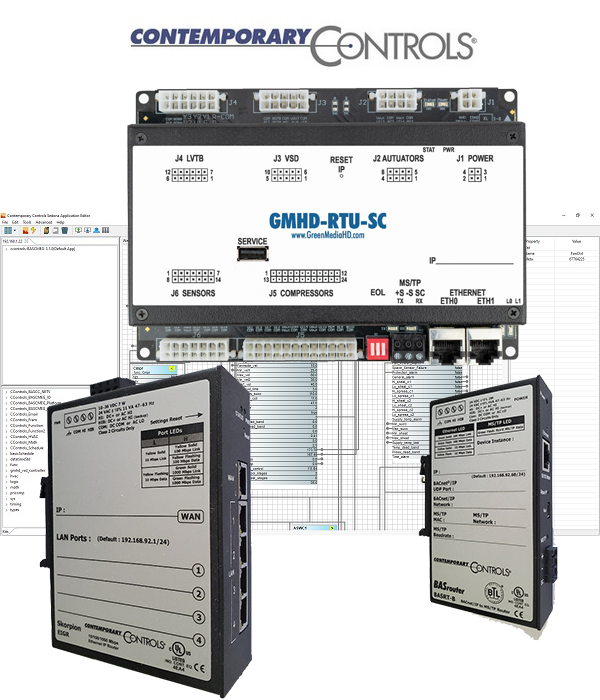Saving Opportunity
Reduce Excess of Air Flow
Most rooftop HVAC systems (over 90%) run at a constant volume. Because the fan is on continuously and the compressor only intermittently, under most conditions (no matter what the occupancy is and no matter what time of day) the fan energy consumption can be greater than the compressor energy consumption.
Although there are several hours during the day when a building may not be fully occupied or the need for ventilation is lower than designed, the ventilation rate cannot be adjusted easily with a constant speed fan.
Retrofitting packaged HVAC units
The investment to retrofit an existing rooftop HVAC unit with advanced controls like the RTU-SC supplied by GreenmediaHD is much less than installing a new unit. Once the retrofit is done, you can save from 30% up to 50% of energy. That allows you to recover your investment in less than two years. Advanced control technology provides variable speed control, which means the rooftop unit only operates at the volume needed. A set of precision sensors are installed in the existing RTU to calculate the exact demand of air flow.
Humidity Reduction
If the evaporator coil is not cold enough, it cannot remove moisture, and it will stop removing moisture at its dewpoint temperature. The lower the airflow, the lower the evaporator coil temperature. Reducing fan speed to a proper value, reduces humidity.
Moisture removal can improve indoor air quality (IAQ) and occupant comfort, while supporting facility operations and maximizing the life of your building, furnishings, and equipment.
Compressor work reduction
When the fan speed is reduced, the fan heat decreases and reduces building cooling load which makes the compressor save energy in cooling mode. At high outside air temperatures, when the outside and inside air mixture is reduced by lowering the fan speed, the building cooling load is also reduced saving compressors energy. The level of carbon dioxide in the air can be monitored to keep a healthy IAQ.
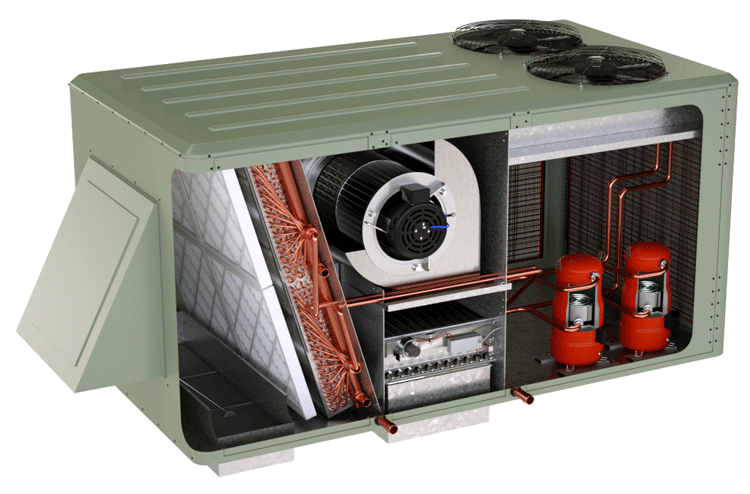
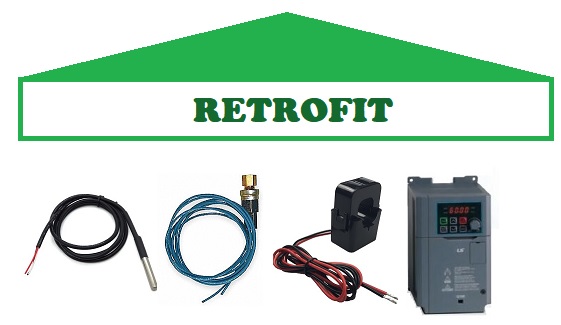
How RTU-SC Works
Fan Speed Modulation
In RTU cool mode, the RTU-SC modulates the fan speed to a proper value while protecting the compressor and keeping a comfortable humidity value. To modulate the fan speed to a proper value, precision sensors are used to measure the parameters used in the optimization algorithms.
With the collected data, important parameters are calculated. One of these parameters is the superheat. Superheat occurs when refrigerant vapor is heated above its boiling point. Superheat is critical in HVAC because it ensures the liquid refrigerant is boiled off before it leaves the evaporator and heads to the compressor, and even small amounts of liquid can cause detrimental damage to the compressor in an HVAC system. RTU-SC set the fan speed to a value that guarantees that superheat is above 7°F and tries to keep this value in a recommended range (7°F-25°F). Other calculated parameters and sensor values are used to control the fan speed to maintain the proper indoor air humidity quality. Optionally, the levels of carbon dioxide in the air are taken into consideration to set fan speed. Finally, energy consumption and energy reduction parameters are calculated to evaluate the energy savings in real time.
For other RTU modes, the fan speed is indexed to a value configured by operative personal and recommended for the building location and environmental conditions.
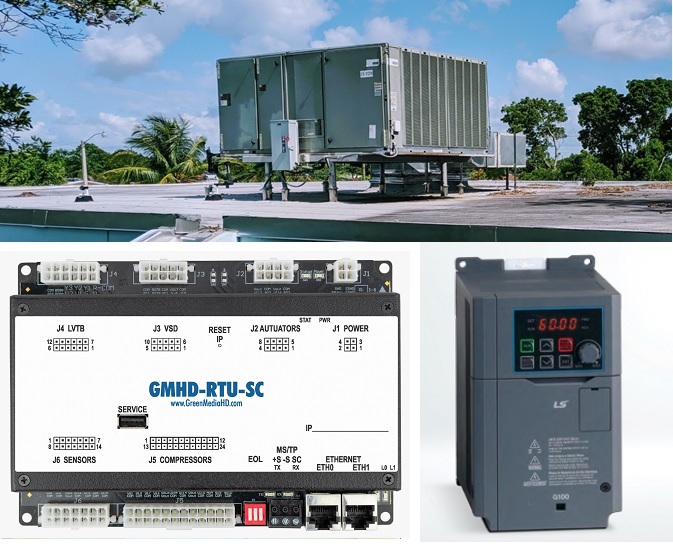
Evaluation Mode
How it is Done
One of the program modules of the RTU-SC deals with energy saving. Precise sensors are used to measure the current and the state of operation of the fan motor. When modulating the fan speed, the RTU-SC calculates the kw consumption and kw-h energy of the fan and compares those values with the nominal kw consumption for a constant fan speed (normally 60hz). The compressors kw consumption and kw-h energy are also calculated.
As a result, we get the reduced kw and kw-h of the RTU due to the speed modulation algorithm used by the RTU-SC.
There is no electrical or electronic device that can measure the energy the RTU does NOT consume. To estimate the energy reduction achieved by the RTU-SC solution, the RTU-SC can be set to operate in “Evaluation Mode” to achieve the most transparent value for energy savings estimate. In this mode the optimization algorithms that modulates the fan speed are enabled only on even days and disabled on odd days. During the odd days, the fan speed is set to the constant nominal value which is the current value if no optimization is applied. Power meters can be installed in the RTU to collect the kw-h energy consumption and compare both days. This evaluation is made for a minimum period of a 15 days.
The main goals of this evaluation mode are:
Get the real energy savings results
By comparing the energy consumption obtained on the even days with those obtained for the odd days, the percent of energy savings for that RTU can be estimated more accurately. Reports are created to show the real energy savings.
Report a real time saving calculations more accurately
The collected data is used to adjust the energy saving program module of the RTU-SC for a more precise result. This module shows in real time the energy reduction results in the IOT Cloud or local dashboard Web pages
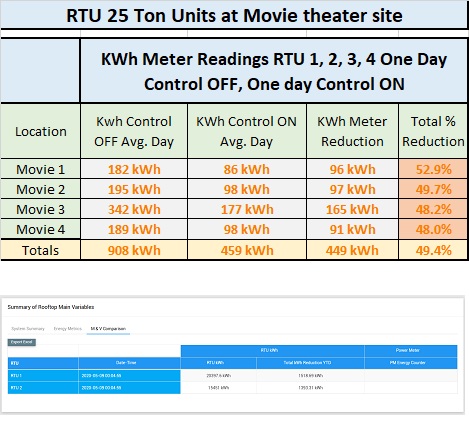
RTU-SC Quick Energy Reduction Estimate
Site Information
The calculations of the energy reduction estimates are based on the results obtained in many other installations of RTU-SC Systems. The results shown have been carried out assuming conservative average parameters of rooftop units, such as the RTU-SC system installation the savings obtained can be much higher.
Electrical Rate ($/KWh):
Number of Warm Months: 6
Total Rooftop Tons: 200
Cooling Hours Per Year:4368
Estimated Energy Reduction Per Year:67000 kWh
Estimated Energy Savings Per Year: $ 6700
Estimated CO2 equivalent Per Year* : 980 Tons
*Calculated using EPA guideline
For these calculations, the following values have been taken into account, according to the statistics obtained in previous installations of the RTU-SC:
Estimated savings in warm months 35%
Estimated savings in winter months 4%
Average cooling capacity in warmer months 85%
Average cooling capacity in winter months 8%
Average kilowatt-hour per refrigeration ton for each RTU 1.25 kwh/ton
It is also considered that in winter the cooling hours are mostly half of summer hours
Main Componets

Precise Sensors and Actuator
A set of precise sensors to get the best and most reliable results in energy savings are installed to retrofit the existing RTU.
The main sensors includes: pressure sensor, temperature sensor, and current transformers.
Optionally, a Wi-Fi indoor IAQ sensor including: Temperature, relative humidity, CO2, VOC, PM2.5 sensor can be installed and integrated to the RTU-SC operation, and an additional KWh meter can be installed.
A Variable Speed Drive (VSD) is installed to modulate the fan speed. The speed value is set by the GMHD-RTU-SC controller when the proper fan speed value is calculated to save energy during cooling mode of the RTU. For the other RTU modes (heating and ventilating), the value of fan speed is indexed according to operational conditions of the RTU set by the maintenance operators.
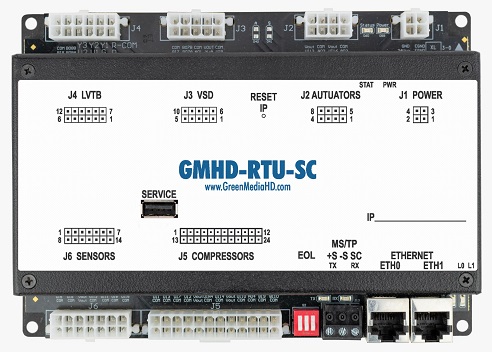
GMHD-RTU-SC Controller
This is the main controller of the RTU-SC and is used to modulate the fan speed to save energy.
This controller, supplied by Contemporary Control System, Inc., was programmed using Sedona Language. Six specialized program components kits were designed by GreenmediaHD for this controller: fan speed controller, alarm supervisor, energy saving calculation, protection module, evaluation module, and schedule module. There are two versions of the software, the Version 1 for controlling only the evaporator fan speed and let RTU temperature control with the existing local thermostat or controlled by an existing BMS, and Version 2 for full RTU control (temperature and evaporator fan speed).
GreenmediaHD also designed a Web Server that is embedded inside the controller and is used as a very user-friendly interface to make for easy installation, fast commissioning, and testing of the controller.
The controller supports RTU from one to three compressor stages. Every RTU uses one GMHD-RTU-SC and all the sensors used in the RTU-SC are connected to this controller.
The controller can operate as an edge controller, where no BMS is necessary to supervise and control its functionality and it can send all data directly to the GreenmediaHD Cloud Server for Cloud Supervision and Control.

GMHD-E6U4R2A Controller
This controller can also be used as the main controller of the RTU-SC. The difference with the GMHD-RTU-SC controller is that it only supports one compressor stage RTU’s.
This controller has the same computation power as the GMHD-RTU-SC controller but supports lower I/O points. It is also supplied by Contemporary Control System, Inc., and uses similar software designed by GreenmediaHD for control functionality, and the embedded Web Server for user interface.
The installation on campus of an RT-SC System can use some RTU with the GMHD-RTU-SC controller and others RTU with the GMHD-E6U4R2A controller depending on the compressor stages in cooling mode.
The controller can also operate as an edge controller, where no BMS is necessary to supervise and control its functionality and it can send all data directly to the GreenmediaHD Cloud Server for Cloud Supervision and Control.

Controllers User Interface
The Web Server embedded inside the GMHD RTU controllers was designed by GreenmediaHD to commission, supervise and control the functionality of the RTU-SC System. It supplies the controller with a very user-friendly interface (UI), turning the Contemporary Controls general-purpose controller into a specific-purpose controller.
The UI groups all the parameters of the RTU in different screens according to the functionality. In that way, we have the main operative parameters screen, set-point setup, schedule setup, trending charts, energy-saving parameters and so on. The groups allow the RTU-SC system installer to make a fast commissioning of the controller, test it properly, and tune the control to optimum performance.
The trending chart screen is very useful for checking the optimal functionality of the controller and set the proper values of the controller depending on the operative condition of the RTU.
Another advantage of this UI is that the maintenance operator can visualize the temperature variables in different measurement unit (°F or °C).
This UI can be accessed from different devices that have a browser (mobiles, laptops, tablets, and desktops) and are connected in the same LAN of the GMHD controllers.
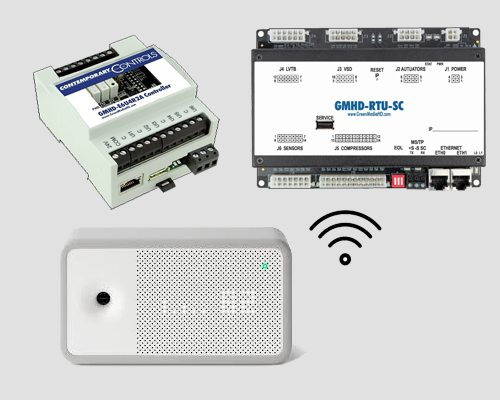
Indoor Air Quality Integration
Each GMHD Controller has the ability to integrate one Awair Indoor Air Quality (IAQ) sensor using the APIs supplied by the manufacturer.
Using the GMHD Controller UI, we can configure all the necessary parameters for the IAQ sensor integration, override the temperature, humidity and CO2 controller analog inputs with the data from IAQ sensor, and upload the IAQ sensor data to the GreenmediaHD Air Quality Cloud System.
All the IAQ data is shown in one of the UI screens. The CO2 value can be configured to be used in the control of the evaporator fan speed to comply with the ASHRAE 62 Indoor Air Quality Procedure (IAQP).
Multiple Awair Indoor Air Quality (IAQ) sensors can be also integrated into the Logger Gateway.
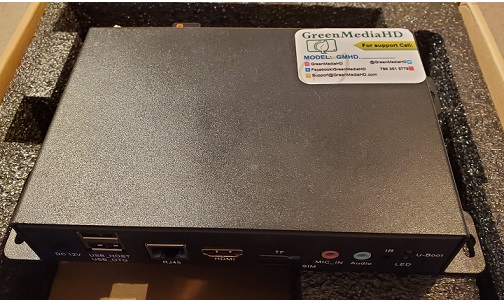
RTU-Logger Gateway
The Gateway is used in places that have multiple RTUs installed, where the RTU-SC System is made up of multiple controllers and it is then necessary to reduce the internet bandwidth by uploading all the data to the Cloud from a single place (the Gateway) instead of each controller uploading the data itself.
This Gateway is connected via BACnet/IP in a local network with every GMHD controller. The functions of the Gateway are: Collect data from all the controllers, send BACnet commands to each controller, synchronize the date and time on all the controllers, send all collected data to the GreenmediaHD Web Server, and receive commands from the GreenmediaHD Web Server and transmit them to the target controller. The Gateway has an embedded Web Server for configuration and an embedded BACnet IP Server that can be used to easily integrate all the GMHD controllers with existing BMS.

GreenMediaHD Cloud Server
All data is sent to the GreenMediaHD Cloud server to be visualized in customized Web Pages Dashboards.
Energy reduction reports are shown in real time allowing evaluation of the everyday energy savings.
Commands like setpoints and schedules to each GMHD controller can be sent from GreenMediaHD Cloud Sever.
GreenMediaHD Cloud Sever also shows a variety of alarms in each RTU and provides some recommendations on how to solve the issues that triggered them.
Integration hardware support
Integration into BACnet field and remote control
Sometimes it is necessary to include additional smart sensors which transmit data using a communication protocol or integrate the RTU-SC System to other devices or a BMS. The RTU-SC allows the integration of any BACnet MS/TP devices, i.e., the Wattnode Power Meters that can be used to verify the energy savings. Secondly, the GMHD controllers and the RTU Logger Gateway can be routed into the existing BACnet architecture of the building using a BBMD that allows BACnet messages to cross subnets which are interconnected with IP routers. Finally, it is possible to remotely access the GMHD Controllers installed programs from the convenience of the system integrator's home or office for maintenance and upgrade purposes.
This integration is possible thanks to the support of Contemporary Controls System, Inc. products.
The main Contemporary Controls products used in the RTU-SC integration support are:
Contemporary Controls Sedona Application Editor
This editor is used to program the optimized saving-energy functions in the GMHD Controllers. It is a vary flexible, easy, and intuitive graphic editor.
BASrouter. BACnet Multi-Network Router
The BASrouter is used to route messages between BACnet/IP, BACnet Ethernet, and BACnet MS/TP networks. If optional power meters are needed to verify the energy savings, the Wattnode Power Meters with BACnet MS/TP protocol are integrated to the RTU-SC using the BASrouter model BASRT-B.
The BASrouter also supports 5 BBMD entries that allows the RTU-SC, if required, to integrate into the subnets of the existing BACnet topology in the building.
RemoteVPN. Simplified Secure Remote Communication
The RemoteVPN is a service offered by Contemporary Controls that allows systems integrators remote access to systems from the convenience of the systems integrator's home or office. This service is especially useful for maintenance and upgrades in the Sedona, or the UI Python programs of each GMHD controller, and provides a way to integrate if necessary, a remote BMS for supervision and control.
Services
RTU Retrofit
We install all the necessary sensors and the VSD in the RTU to modulate the fan speed and make energy calculations. Also, if required, the BACnet IP communication network is installed to connect all the controllers to the Gateway.
Installation of the GMHD Controllers and Logger Gateway
The GMHD controller is installed in the RTU, and all its parameters are set up for best results using the controller UI. If required, these parameters are mapped into the Logger Gateway. This Gateway is also configured for optimum results for the characteristics of the target RTU’s.
RTU-SC Cloud Analytics
A user account is created in the RTU-SC Web Server to monitor and have some control of all RTUs from anywhere. Evaluation and energy-saving reports, and much more information about the RTU’s is displayed in dashboards.
Bacnet IP server for Integration
The RTU Logger Gateway and the GMHD Controllers, have a built-in BACnet IP server that allows third-party integrators of other building systems, such as existing BMS, to get all the parameters measured and calculated by the RTU-SC as well as send back commands to the controllers.
Continuous update of the RTU-SC
Whenever a new Gateway Software Version is available, the user can download it from the RTU-SC Web Server and install it in the RTU Logger Gateway. Optionally a VPN can be installed to remotely update every GMHD controller when a new software version is available.
Consulting and technical support
We prepare the maintenance operators on campus to operate the RTU-SC by themselves and we also provide support and recommendations to get the best energy savings results.





